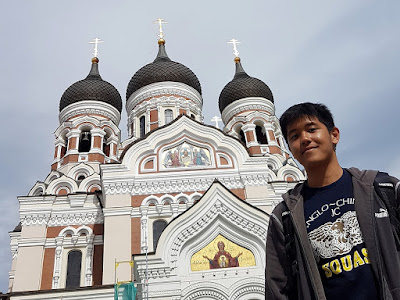Tallinn, Estonia
Tallinn is the capital and the largest city of Estonia. It retains its walled Old Town, which is known as Vanalinn in the local language. Covering an area of 110 hectares with a population count of no less than 4,500, Vanalinn was inscribed as a UNESCO World Heritage Site in 1997 due to its exceptionally intact 13th century city plan.
It's easy reach to Vanalinn by foot from
Tallinn Passenger Port. All you need to do is to follow the crowd and walk towards the direction of a tall tower that you can't miss.
 |
| That's the tower of St. Olaf's Church. |
 |
| There are four tram lines in Tallinn. |
My BFF and I first dropped by a small landscaped garden called Kanuti Garden.
 |
| The bird above the umbrella isn't part of the sculpture. |
Vanalinn was once a home to wealthy merchants settling from Germany, Denmark and beyond.
 |
| I wasn't expecting to see a sports nutrition supplement store there. |
 |
| Navigate your way through twisting cobblestone lanes~ |
 |
| The first wall around the Old Town was constructed in 1265. |
We walked past St. Nicholas' Orthodox Church. Unfortunately, it was closed at that time, so we couldn't see the interior.
 |
| It was the first church with twin towers in Tallinn, constructed between 1822 and 1827. |
Vanalinn's Town Hall Square, where the Brotherhood of the Blackheads is thought to have erected the world's very first Christmas tree, has been holding Christmas festivals since 1441.
 |
| Bike taxis are abundant there. |
 |
| Tallinn Town Hall is the oldest town hall in the whole of the Baltic region. |
As our stomachs started to growl, we tried to find a nice restaurant for lunch.
 |
| Accessories made of fossilised tree resin, anyone? |
 |
| A wishinig well? |
Satisfied and recharged, we climbed up to Danish King's Garden on the slopes of Toompea Hill, where King Valdemar II of Denmark and his stroops camped before conquering Toompea in 1219.
 |
| Legend has it that a red flag with a white cross descended from the sky, spurring the Danes on to victory when fighting the Estonians. The flag has since become the national flag of Denmark. |
 |
| Neitsitorn (lit. Maiden Tower) Museum used to be a defence tower built in 1370. |
From there, we made our way to Alexander Nevsky Cathedral. Photography isn't permitted inside the iconic Orthodox cathedral.
 |
| Designed in a typical Russian Revival Style, the cathedral was erected between 1894 and 1900. |
 |
| The cathedral is dedicated to Saint Alexander Nevsky who won the Battle of the Ice in 1242. |
 |
| A 20-minute tour on the city 'train' costs €6.00 (~S$9.20) per adult and €4.00 (~S$6.15) per child. |
There's one public toilet near the cathedral that looks unique from outside.
Having clocked at least 20,000 steps each for the day, we continued walking.
 |
| Voldemar Panso was a renowned Estonian theatre director and performer. |
St. Nicholas' Church was built in the 13th century, but it was partially destroyed during World War II. After its restoration, it houses a branch of the Art Museum of Estonia, which focuses mainly on ecclesiastical art from the Middle Ages and beyond. An adult tickets costs €6.00 (~S$9.20), while a child ticket costs €5.00 (~S$7.65).
 |
| I didn't enter the museum, but managed to snap one photo of the interior outside of the paid area. |
By then, I could certainly use a foot massage.
 |
| We took a 10-minute break on that bench. |
 |
| The memorial consisting of 143 glass plates commemorates soldiers and civilians who were killed during the Estonian War of Independence from 1918 to 1920. |
 |
| St. John's Church is a Lutheran church that was completed and consecrated in December 1867. |
Looking at the time, we wandered about just a bit more.
 |
| I was tempted to have some coffee at one of the cafés, but decided not to. |
 |
An irritating souvenir medallion machine that requires you to insert not only one €1.00 coin,
but also one €0.05 coin for a (total ~S$1.60)! |
Feeling peckish, I bought a cup of cherries for €3.00 (~S$4.60).
It was time to leave Vanalinn and head to Tallinn Passenger Port.
 |
| Olde Hansa is a restaurant famous for its "most authentic medieval dining experience ever". |
 |
| We left the area through Great Coastal Gate. |
A monument that took us by surprise as we'd had no idea about its existence until we stumbled upon it, Broken Line was erected in memory of 852 individuals who perished when MS Estonia sank in the Baltic Sea in 1994. It was one of the worst maritime disasters of the 20th century with 137 survivors.
 |
| Out of the 852, 757 of whom have never been found. |
'Twas a fantastic one-day trip to Estonia.



















































































































Comments
Post a Comment